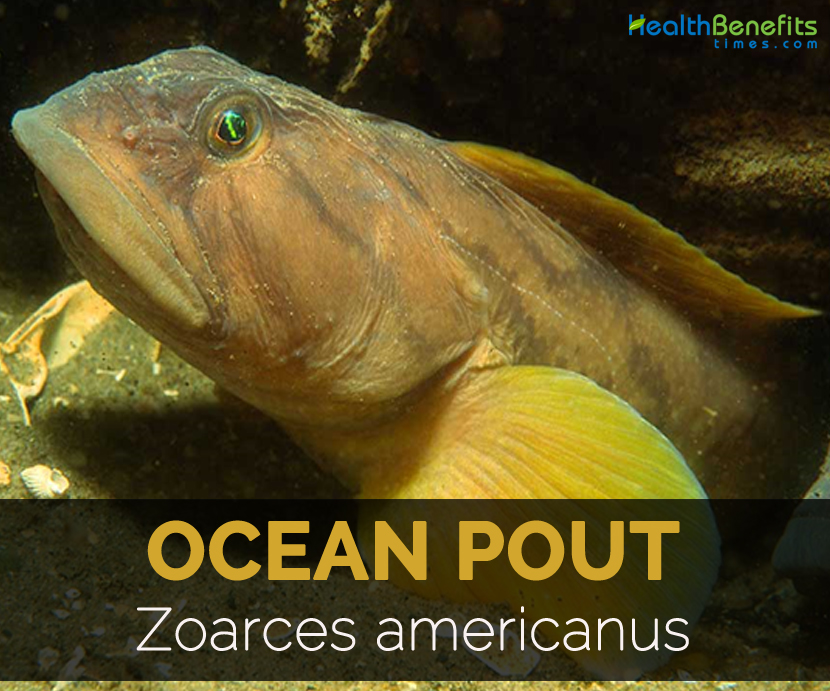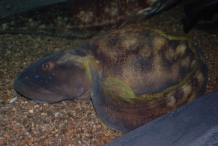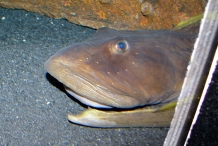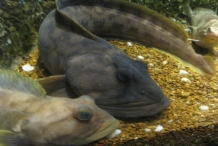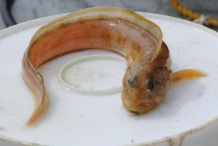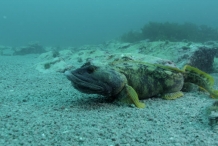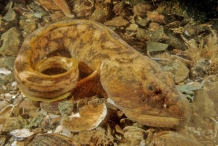| Ocean pout Quick Facts |
| Name: |
Ocean pout |
| Scientific Name: |
Zoarces americanus |
| Origin |
They are available in Northwest Atlantic Ocean, off coast of Eastern Canada and New England. |
| Colors |
Reddish brown spotted with olive |
| Shapes |
Eel-like or Blenny-like; Length: 3½ feet (42 inches) |
| Flesh colors |
White |
| Calories |
140 Kcal./cup |
| Major nutrients |
Selenium (116.55%)
Isoleucine (80.56%)
Lysine (80.26%)
Tryptophan (74.32%)
Threonine (72.78%)
|
| Health benefits |
Maintain cells, Regenerates tissues and cells, Prevent weakness, Treats Premenstrual Syndrome, Maintains cholesterol level |
The Ocean pout scientifically known as Zoarces americanus, are the fish of Zoarcidae family having the body resembling eel-like or blenny-like of 3½ feet (42 inches) long. An upper body is muddy yellow to mottled reddish brown which blends to dirty white or yellowish underbody. It have continuous dorsal fin running from nape of neck back to tail fin. The anal fin starts from mid body running back towards tail fin connecting to it. They have wide and gaping mouth having thick and fleshy lips or armed jaws with blunt, strong and conical teeth. The body is deep and eight times long. It could reach upto 42 inches in length weighing 12 pounds.
They are available in Northwest Atlantic Ocean, off coast of Eastern Canada and New England. The blood of Ocean pout contains antifreeze proteins due to which it could survive in freezing waters. It feeds on the prey such as marine worms, brittle stars, sea urchins, shrimp, amphipods, crabs, molluscs and welks. Spawning takes place from late August to September. Ocean pout is also known as Marine stubborn, Pout, Eelpout, Mother-of-eels, Mutton fish, North-Atlantic ocean pout, Poodler, Shore eelpout, Eel pout and Conger eel.
Description
The body of Ocean pout resembles blenny or eel which is about 42 inches long. The sides are flattened, tapered and sway bellied. The skin is slimy and scales are small. The dorsal fin consists of 95 to 100 soft rays. It has large and rounded pectoral fins. Small ventrals are found in front of pectorals on the throat. The upper lips are soft which encloses the tip of lower lip when it closes its wide mouth. The mouth is full of strong and blunt conical teeth. It consists of 131 to 141 vertebrae. The skin is yellow or brown that is spotted with various dark patches. It usually weighs upto 12 pounds.
Nutritional value
Cooked Ocean pout of 0.5 fillets carries 104.26 g of moisture, 140 calories, 29.22 g of protein, 1.6 g of total lipid fat and 1.99 g of ash. The same serving size grants 116.55% of Daily Value of Selenium, 80.56% of DV of Isoleucine, 80.26% of DV of Lysine, 74.32% of DV of Tryptophan, 72.78% of DV of Threonine, 71.31% of DV of Valine, 69.81% of Histidine, 64.29% of Leucine, 59.17% of Vitamin B12, 58.44% of DV of Protein, 50.14% of DV of Phosphorus, 29.15% of DV of Vitamin B6, 21.90% of Niacin, 16.45% of DV of Zinc, 14.96% of DV of Potassium and 10.50% of DV of Thiamin.
Health Benefits of Ocean pout
Ocean pout is loaded with various amounts of nutrients that help to maintain healthy body. It has high concentration of selenium, isoleucine, lysine and others. With an intake of Ocean pout, one could derive various health advantages as it contains different amounts of minerals, vitamins, lipids and amino acids. It helps to prevent health ailments as well.
- Maintain cells
Cobalamine assists to maintain various cells in human body along with carrying the functions such as repair, formation, maintenance of RBC. It also takes care of nerve cells in the body and maintains strong nervous system. (1)
- Regenerates tissues and cells
Protein is essential for the restoration and renewal of tissues and cells in body. It requires amino acids for the formation of new tissues and cells such as hair, nails and skin. The body should replace the reduced cells that help to maintain good health. It is also used for the production of cell regenerative medicines. (2) (3)
- Prevent weakness
Phosphorus is essential for solving ailments such as numbness, muscle weakness and fatigue. The body requires adequate amount of phosphorus to become fit. It also cures sexual weakness, impotence, sperm motility, frigidity and loss of libido. (4)
- Treats Premenstrual Syndrome
Pyridoxine helps to cure premenstrual syndrome that occurs in women which is reduced. It results in loss of sex drive and moodiness. Vitamin B6 helps to cure this condition. (5)
- Maintains cholesterol level
The high intake of niacin helps to lower LDL cholesterol and increase HDL cholesterol. It also prevents the thickening of artery walls and atherosclerosis. (6)
- Prevent acne
It prevents acne and regulates testosterone level in the body. Additionally, it is also involved in collagen synthesis. It normalizes the skin oils and promotes the skin health. Zinc promotes the count of white blood cells and lowers the risk of infection. Zinc reduce the appearance of scars. (7)
- Treat cramps
The deficiency of potassium causes cramps in muscles that is known as hypokalemia. The high intake of potassium prevents muscle cramps. (8)
- Provides energy
Sugar is the great source of energy. Vitamin B1 oxidizes the usable form of energy. It plays a vital role in pyruvate dehydrogenase system that assists in sugar oxidation. Vitamin B1 is essential for the functions of enzyme system that supports in various functions. (9)
- Enhance immunity
Vitamin B1 promotes the immunity power by promoting antibodies and reinforce defense system to counteract infections.
- Nervous health
Riboflavin cures nervous ailments such as Alzheimer’s disease, numbness, anxiety, multiple sclerosis and epilepsy. It helps to treat painful symptoms of Carpal Tunnel Syndrome.
Precautions
- Limit the intake of Ocean pout.
- It is safe to consult the doctor by pregnant women and health patients before consuming it.
- It should be properly cooked for consumption.
How to Eat
- In Italy, it is panfried with chives by seasoning with salt and pepper.
- It is boiled, deep fried, grilled or roasted.
- It is also added to soups and stews.
References:
https://www.organicfacts.net/health-benefits/vitamins/health-benefits-of-vitamin-b2-or-riboflavin.html
https://www.itis.gov/servlet/SingleRpt/SingleRpt?search_topic=TSN&search_value=630979#null
https://www.maine.gov/dmr/recreational-fishing/anglers-guide/doyouknowyourcatch/documents/oceanpout.pdf
Comments
comments


